-
Author: Amar Kirale
- >> Post Created: November 21, 2020
- >> Last Updated: May 5, 2024
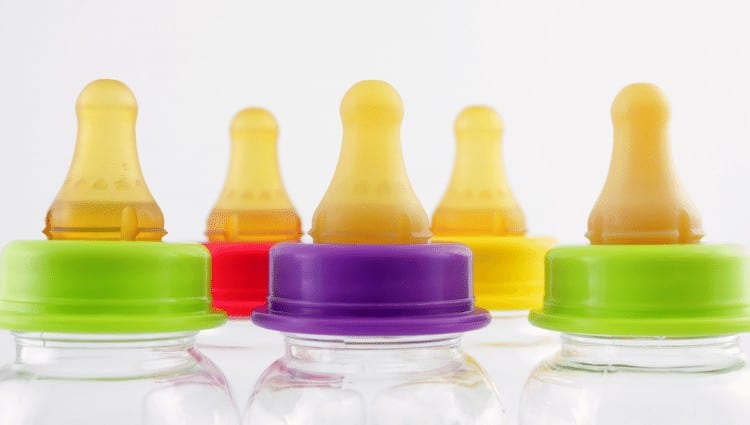
How to Sterilize Baby Bottles - Table of Contents
Babies was completely protected in the womb, but now that they are out into the big bad world, they are exposed to numerous germs on a daily basis.
You might say, “My house does not have germs, I clean it diligently and regularly.” But cleaning does not mean sterilizing. There can still be germs around you and sometimes even on you that do not harm you because you have developed the required immunity against them, but your little one does not have a well-developed immune system yet and will take time to build-up resistance to these common pesky germs.
To help protect your baby till such time they develop their immunity, ensure that at least those things that go into your child’s mouth are sanitized. You can sterilize baby bottles, bottle caps, teats, teething rings… in short, anything that goes into their mouths.
You can go through this article to know exactly how to sterilize baby bottles – the various different ways. Further you can read our article where we help you with some of the best baby bottle sterilizers which not only sterilize baby bottles but other baby things as well.
Do have a look it will help you in selecting the best baby bottle sterilizer that suites you and your child.
When to sterilize baby bottles?
You may feel that just washing bottles is more than sufficient, but it is advised to sterilize baby bottles for the first 12 months. You may stop sanitizing bottles before that, but ensure you sterilize baby bottles and other feeding accessories at least during the first 3 months.
During these COVID-19 times you may even want to continue to sterilize all the feeding equipment even after your baby is older.
It is recommended that you sterilize baby bottles and other feeding accessories during the following instances:
- If you are using second-hand bottles and feeding equipment (which includes baby bottles that your older kids used), you need to sterilize them before use.
- If your baby is sick, it is better to sterilize baby bottles before each use to avoid any further infections, as their immune systems will already be working overtime to fight off the baby’s sickness.
- If your baby is premature, their immune systems will be a lot more compromised; hence, sterilizing baby bottles to avoid the exposure to those pesky germs is a good idea.
- If your baby has any health issues that is causing their immune system to be affected, then sanitize baby bottles and all other feeding equipment to keep them healthy.
- If you live in a place that does not have access to clean drinking water, then you have to make sure you always sterilize baby bottles.
How to clean baby bottles?
Before you sterilize baby bottles and other feeding equipment, you need to clean everything to remove any traces of milk and formula in the bottle.
But remember cleaning will not remove the germs; you will have to sterilize baby bottles after cleaning them.
You can clean the bottles by hand or in the dishwasher if your bottles and other feeding equipment are dishwasher safe.
By hand
Step 1: Rinse everything with clean water.
Step 2: Submerge the baby bottles along with the other feeding equipment in some hot soapy water.
Step 3: Use a brush to clean inside the bottle thoroughly and clean all the other equipment with your hands or brush.
Step 4: Rinse everything with clean water.
Step 5: Shake of any excess water and place everything on a clean towel to air dry.
In the dishwasher
Step 1: Open all the bottles and separate the parts to load into the dishwasher.
Step 2: Place all the parts in a dishwasher-safe basket to prevent small parts from falling to the bottom of the dishwasher.
Step 3: If your dishwasher has a sanitizing setting you can clean and sanitize baby bottles at the same time or you could run the dishwasher in the hot-water cleaning and heated drying to clean it properly.
Step 4: Remove all the bottles and feeding accessories and place them on a clean towel to air dry.
How to sterilize baby bottles—all sterilizing methods
Sterilizing is a way in which you can kill harmful germs, bacteria, and viruses that may be present on the surfaces of the baby bottles and other feeding equipment.
There are many ways in which you can sanitize baby bottles and other feeding accessories. You can select a method that suits your family needs and requirements.
You can select more than one sterilizing method to suffice different needs and situations. To help you understand how to sterilize baby bottles, we are listing down every possible sterilizing method for you to choose from.
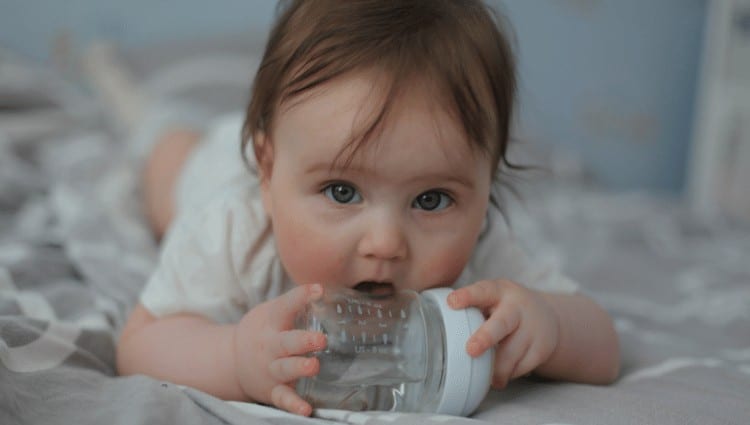
How to sterilize baby bottles by boiling?
Boiling baby bottle is the most common way to sterilize baby bottles around the world. It is also the cheapest and the oldest sterilizing method.
Boiling raises the temperature enough to kill the harmful germs that can be present on the surface of baby bottle and other feeding accessories.
Follow the steps to understand how to sterilize baby bottles by boiling:
Step 1: Take a clean saucepan and fill it with clean water.
Step 2: Fill the pan with all the bottle parts and other feeding accessories that have been cleaned to remove any residue of milk or formula.
Step 3: Make sure the bottles and other equipment remains submerged in the water without any air bubbles.
Step 4: If you feel the water is not enough to submerge everything, add some more clean water into the pan.
Step 5: Now place the pan on a burner and bring it to boil.
Step 6: Covering the pan will help the water boil more rapidly.
Step 7: Boil for 5 to 10 minutes and then turn the stove off.
Step 8: Allow the water to naturally cool down.
Step 9: Once the water is cool wash your hands before you remove the equipment from the water. You can also use a pair of clean tongs to remove the feeding equipment.
Step 10: Shake the baby bottles to remove excess water and then let it air dry on a clean towel.
Step 11: If you are not planning on using the bottles right away, you can place them in a clean container and keep it in the fridge.
Step 12: Ensure you re-boil all the feeding equipment if you don’t use them within 24 hours of sterilizing.
How to sterilize baby bottles in a microwave?
Another easy way to sanitize bottles is just placing them in the microwave. This may not be the best way, but it certainly is easy.
Follow the steps to understand how to sterilize baby bottles in a microwave:
Step 1: Clean your microwave thoroughly.
Step 2: Clean the baby bottles and fill them halfway with clean water.
Step 3: Take a separate glass bowl with clean water and submerge other feeding accessories in the bowl.
Step 4: Place everything in the microwave and start it on high for one and a half minute to sterilize everything.
Step 5: Let everything cool down before you touch them. You don’t want to burn your fingers.
Step 6: Once the water is cool enough, remove everything and shake the excess water out and place it on a clean towel to air dry.
How to sanitize baby bottles in a microwave steamer?
This method will require you to buy microwave steamers or microwave steamer bags. They are comparatively easy to use and are cheaper than the electric steamers that work on the same concept.
It is travel friendly, especially the steamer bags, as all you need is access to a microwave to use it anywhere.
Microwave steamers or microwave steamer bags use steam to eliminate any harmful germs.
Follow the steps to understand how to sterilize baby bottles in a microwave steamer or microwave steamer bags:
Step 1: Clean the microwave thoroughly.
Step 2: Fill the microwave steamer with clean water in the amount instructed by the manufacturer.
Step 3: Clean the baby bottles and other feeding accessories before placing them in the microwave steamer or microwave steamer bag.
Step 4: Close the microwave steamer and place it in the microwave.
Step 5: Set the temperature and time of the microwave as instructed by the manufacturer.
Step 6: Wait for the microwave steamer to cool down for a few minutes before opening it and removing the baby bottles.
Step 7: Shake the excess water out from the bottles and place them on a clean towel to air dry.
How to sterilize baby bottles in an electric steamer?
Electric steamers are more expensive than the microwave steamers, and many of them will need some dedicated counter space.
On the other hand it can sterilize a lot more bottles in one go than the microwave steamers and bags. Some can keep the products sterilized for 24, 48, and even 72 hours. Some of these electric steamers also have the drying function.
So make sure you consider all the pros and cons before investing in this machine.
Follow the steps to understand how to sterilize baby bottles in an electric steamer:
Step 1: Clean the baby bottles and other feeding accessories before you load them into the electric steamer.
Step 2: Add the required amount of clean water in the electric steamer as per the manufacturer’s instructions.
Step 3: Place all the bottles upside down in the steamer along with other feeding accessories that you can fit into the machine.
Step 4: Connect the machine to an electric outlet and turn it on as per the manufacturer’s instructions.
Step 5: Most of these machines come with an automatic turn-off feature so you don’t have to worry about when to turn it off.
Step 6: After the machine is done with the sterilizing cycle, you need to wait for the bottles to cool down and then open the machine and remove the bottles.
Step 7: If you don’t want to use the bottles immediately just leave them in the machine and only open it when you want to use it.
Step 8: Some machines can keep the feeding equipment sterilized for 24, 48, or even 72 hours if the equipment is left in the machine without opening. Check the manufacturer’s instruction to know the process.
Step 9: Once you remove the bottles shake the excess water off and place them on a clean towel to air dry.
Step 10: Some high-end machines also come with a drying function along with sterilizing. Follow the manufacturer’s instructions to know the process.
How to sterilize baby bottles in a UV sterilizer?
UV sterilizers use ultraviolet rays to kill all forms of bacteria and viruses that may be present on the surface of a variety of products. These sterilizers have been used in medical and research facilities for a long time and are now available for home use.
They are definitely the most expensive option, but they are also the most versatile. As there is no heat, water, or steam involved, these machines can be used for a varied number of things.
Many people have been using these machines to sterilize their phones, wallets, keys, remotes, etc. during these COVID-19 times. So it is not just restricted to baby products and, therefore, has a lot more long-term use than other options.
Follow the steps to understand how to sterilize baby bottles in a UV sterilizer:
Step 1: Place all the cleaned equipment that needs to be sterilized into the machine.
Step 2: Press start and follow the manufacturer’s instructions for the ideal settings.
Step 3: These machines have an auto shut-off feature so you don’t have worry about the timing.
Step 4: Many machines have the option of leaving the equipment inside the machine for 24, 48, or even 72 hours to keep them sterilized.
Step 5: As there was no heat or water involved, you can directly remove the products from the machine and start using them.
How to sterilize baby bottles in the dishwasher?
If your baby bottles and feeding products are dishwasher safe and your dishwasher has a sterilizing function, then this can become one of the best options for you to sanitize your baby’s feeding equipment.
You can check the manual to see if your dishwasher has the NSF/ANSI Standard 184 Certification. If it does, then it can be used for sanitizing baby bottles and other feeding equipment.
Follow the steps to understand how to sterilize baby bottles in a dishwasher:
Step 1: Open all the bottles and separate the parts to load into the dishwasher.
Step 2: Place all the parts in a dishwasher-safe basket to prevent small parts from falling to the bottom of the dishwasher.
Step 3: Select the sanitizing setting or follow the manufacturer’s instructions to ensure your baby products are thoroughly sanitized.
Step 4: Remove all the bottles and feeding accessories and place it on a clean towel to air dry.
How to sterilize baby bottles with chemical tablets and liquids?
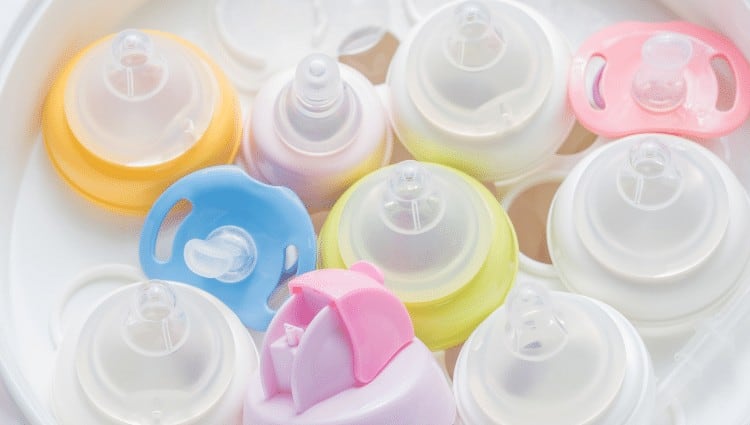
Chemical sterilizers are basically disinfectants that come in either tablet or liquid form that you have to dilute in clean water to use.
This is a quick and easy way to sterilize baby products, especially while travelling. It is also comparatively cheaper.
Follow the steps to understand how to sterilize baby bottles with chemical tablets and liquids:
Step 1: Make the sterilizing solution as per the manufacturer’s instructions.
Step 2: Clean all the baby bottles and feeding accessories before placing them in the sterilizing solution.
Step 3: Submerge all the feeding equipment in the solution and ensure that there are no air bubbles.
Step 4: Leave everything in the solution for the time specified by the manufacturer.
Step 5: Drain all the solution out and let it air dry on a clean towel when you want to use the baby products. Do not rinse the products as it will remove all the sterilizing solution exposing the products to germs again.
Step 6: You need to throw away the sterilizing solution after 24 hours and clean the container thoroughly before reusing.
How to sanitize baby bottles with bleach?
Bleach is another option for sterilizing baby bottles and feeding accessories. It is cheap and easy, but it is only recommended when you do not have access to other sterilizing options.
Using bleach regularly may not be the best idea.
Follow the steps to understand how to sterilize baby bottles with chemical tablets and liquids:
Step 1: Dissolve 1 teaspoon of bleach (preferably unscented) into 16 cups of clean hot water.
Step 2: Clean all the baby bottles and feeding accessories before placing them in the container of bleach solution.
Step 3: Ensure all the feeding equipment is submerged in the solution without any air bubbles.
Step 4: Let the products soak in the bleach solution for 2–5 minutes.
Step 5: Remove the products from the container with the help of a pair of clean tongs.
Step 6: Shake the excess water off before placing the feeding equipment on a clean towel to air dry. The remaining bleach will breakdown easily during this air drying process and, therefore, will not harm your baby.
Safety tips
When you are following the process of how to sanitize baby bottles, there are some general guideline and safety tips that you need to follow:
- Some nipples cannot handle the higher temperatures and may start cracking. Read the manufacturer’s specification before subjecting them to high temperatures.
- Buying bottles that are free of toxins, BPA, and other chemicals will ensure that these chemicals do not leak when these bottles are subjected to high temperatures.
- Glass bottles are one of the safest options in such cases as they can withstand higher temperatures compared to plastic bottles. But the bottle can crack and break easily if it falls down.
- Ensure that the equipment you use during the sterilization process like water, towel, tongs, container, etc. are clean.
- Keep the hot water container, steamers, and other high temperature apparatus away from your children grasps to avoid accidents. Hot steam can cause burns as easily as boiling water.
- If you have chemical tablets, liquids, bleach, or any other chemicals, then keep them far away from your children’s reach.
- Washing your hands before you handle the sterilized feeding equipment is a must to ensure a germ-free environment.
- If you are using bleach solution to sterilize baby bottle, ensure that the solution is always diluted as per instructions. Undiluted bleach is very harmful and even fatal if ingested.
- Using filtered water is a better option when you are using electric and microwave steamers, as this will help avoid salt build up in the machine that can happen if you use hard water instead. This will make cleaning and maintaining the machine easier.
Final thoughts
Whether to sterilize baby bottles or not may have been an option previously, but in these COVID-19 times, it has become a necessity.
If your pocket does not allow you to spend heavily on sanitizing machines, using boiling water is always an option available.
We have given a step-by-step guide on how to sterilize baby bottles in this article for every possible sterilizing method. We hope this helps you to keep your baby safer in these testing times.
For any further questions you can always reach us. Let us know if you have any other sterilizing methods or hacks that we have not covered. We will be happy to hear from you.
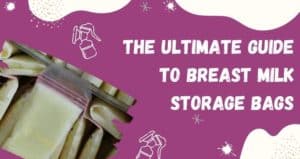
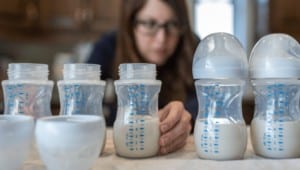
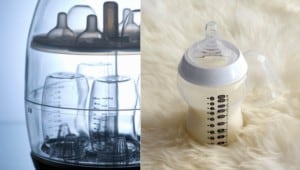

Well I truly enjoyed studying it. This information provided by you is very helpful for correct planning. Shel Gale Dusen